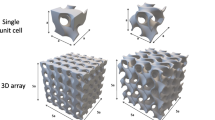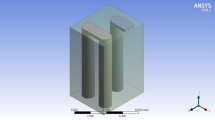Abstract
One of the most commonly used techniques in heat transfer enhancement studies is loose-fit twisted tape with variety of configurations. Optimizing the configurations prevents additional effort, time and cost losses. In this regard, the current research examined the impacts of design parameters identified as twist ratio, clearance ratio, and Reynolds number of the loose-fit twisted tape with trapezoidal wings used in a heat exchanger pipe on pressure drop and heat transfer. For the optimization study, the impacts of three various twist and clearance ratios, and six various Reynolds numbers on the friction factor, Nusselt number, and thermohydraulic performance factor identified as performance parameters were evaluated. The optimum conditions were revealed by conducting the signal-to-noise ratio analysis of the Taguchi method for the purpose of maximizing/minimizing the response variables on an individual basis. As methodology, multi-criteria decision-making problem was applied because of the optimum conditions depending on many variables and various response variables. The solution of the multi-objective optimization problem was provided by employing a pair of methods of the AHP/ TOPSIS. The analysis of variance was performed to determine the extent to which every parameter contributed to the response variables. According to the ANOVA findings, the most effective parameter was the Reynolds number. The Reynolds number of 18000, the twist ratio of 2, and the clearance ratio of 0.0178 were chosen as the multi-objective optimum conditions. In relation the results, an approach regarding the optimum design parameters, which has not been revealed before in the use of loose-fit twisted tape, has been put forward.









Similar content being viewed by others
Abbreviations
- c p :
-
Specific heat capacity of air, J kg−1 K−1
- D :
-
Inner diameter of the tube, m
- f :
-
Friction factor
- h :
-
Heat transfer coefficient, W m−2 K−1
- k :
-
Thermal conductivity, W m−1 K−1
- L :
-
Length of the test tube, m
- Nu :
-
Nusselt number, hD/k
- \(\Delta P\) :
-
Pressure drop, N m−2
- Pr :
-
Prandtl number, μcp,/k
- Q :
-
Heat transfer, W
- q :
-
Heat flux, W m−2
- Re :
-
Reynolds number, UmD/ν
- T :
-
Steady-state temperature, K
- U :
-
Fluid velocity, m s−1
- w :
-
Twisted tape width, m
- x :
-
Axial direction
- y :
-
Twist length of the twisted tape, m
- CI :
-
Consistency index
- CR :
-
Consistency ratio
- RI :
-
Random consistency index
- a :
-
The output
- r :
-
Normalized decision matrix
- w :
-
Mass of criteria
- A * :
-
Positive ideal solution
- A − :
-
Negative ideal solution
- S i * :
-
The distance between performance scores from the positive ideal for each alternative
- Si :
-
The distance between performance scores from the negative ideal for each alternative
- C *i :
-
Relative closeness value of alternative I
- J :
-
The class of benefit criteria
- J’:
-
The class of cost criteria
- ρ :
-
Fluid density, kg m−3
- μ :
-
Fluid dynamic viscosity, kg ms−1
- \(\eta\) :
-
Thermohydraulic performance factor
- \(\nu\) :
-
Fluid kinematic viscosity, m2 s−1
- \(\lambda\) :
-
Eigen value
- b :
-
Bulk
- iw :
-
Inner surface of the test tube
- p :
-
Plain tube
- pp :
-
Pumping power
- t :
-
Tube with twisted tape
- max :
-
Maximum
- j :
-
Criteria
- i :
-
Alternatives
References
Khoshvaght-Aliabadi M, Feizabadi A. Performance intensification of tubular heat exchangers using compound twisted-tape and twisted-tube. Chem Eng Process Process Intensif. 2020;148:107799.
Changa SW, Wub PS, Liuc JH. Aerothermal performance of square duct enhanced by twisted tape with inclined ribs and slots. Int J Heat Mass Transf. 2021;177:121547.
Eiamsa-ard S, Changcharoen W, Beigzadeh R, Eiamsa-ard P, Wongcharee K, Chuwattanakul V. Influence of co/counter arrangements of multiple twisted-tape bundles on heat transfer intensification. Chem Eng Process Process Intensif. 2021;160:108304.
Abolarin SM, Everts M, Meyer JP. Heat transfer and pressure drop characteristics of alternating clockwise and counter clockwise twisted tape inserts in the transitional flow regime. Int J Heat Mass Transf. 2019;133:203–17.
Nakhchi ME, Hatami M, Rahmati M. Experimental investigation of heat transfer enhancement of a heat exchanger tube equipped with double-cut twisted tapes. Appl Therm Eng. 2020;180:115863.
Kosker M, Yilmaz F. The cross-sectional curvature effect of twisted tapes on heat transfer performance. Chem Eng Process Process Intensif. 2020;154:108008.
Al-Obaidi AR. Analysis of the flow field, thermal performance, and heat transfer augmentation in circular tube using different dimple geometrical configurations with internal twisted-tape insert. Heat Transfer. 2020;49:4153–72.
Kumar B, Patil AK, Jain S, Kumar M. Effects of double V cuts in perforated twisted tape insert: an experimental study. Heat Transf Eng. 2020;41:1473–84.
Soudagar ME, Kalam MA, Sajid MU, Afzal A, Banapurmath NR, Akram N, Mane SD, Saleel CA. Thermal analyses of minichannels and use of mathematical and numerical models. Numer Heat Transf Part A. 2020;77:497–537.
Sajid MU, Ali HM, Bicer Y. Exergetic performance assessment ofmagnesium oxide–water nanofluid in corrugatedminichannel heat sinks: An experimental study. Int J Energy Res. 2022;46:9985–10001.
Nawaz S, et al. Oriented square shaped pin-fin heat sink: performance evaluation employing mixture based on ethylene glycol/water graphene oxide nanofluid. Appl Therm Eng. 2022;206:118085.
Sajid MU, Ali HM, Sufyan A, Rashid D, Zahid SU, Rehman WU. Experimental investigation of TiO2–water nanofluid flow and heat transfer inside wavy mini-channel heat sinks. J Therm Anal Calorim. 2019;137:1279–94.
Sheikholeslami M, Ebrahimpour Z. Thermal improvement of linear fresnel solar system utilizing Al2O3-water nanofluid and multi-way twisted tape. Int J Therm Sci. 2022;176:107505.
Sheikholeslami M, Said Z, Jafaryar M. Hydrothermal analysis for a parabolic solar unit with wavy absorber pipe and nanofluid. Renew Energy. 2022;188:922–32.
Sheikholeslami M, Jafaryar M, Bargezar GM. Influence of novel turbulator on efficiency of solar collector system. Environ Technol Innov. 2022;26:10283.
Sheikholeslami M, Farshad SA. Nanoparticles transportation with turbulent regime through a solar collector with helical tapes. Adv Powder Technol. 2022;33: 103510.
Celik N, Pusat G, Turgut E. Application of Taguchi method and grey relational analysis on a turbulated heat exchanger. Int J Therm Sci. 2018;124:85–97.
Bademlioglu AH, Canbolat AS, Yamankaradeniz N, Kaynakli O. Investigation of parameters affecting organic rankine cycle efficiency by using Taguchi and ANOVA methods. Appl Therm Eng. 2018;145:221–8.
Özakın AN, Kaya F. Experimental thermodynamic analysis of air-based PVT system using fins in different materials: Optimization of control parameters by Taguchi method and ANOVA. Sol Energy. 2020;197:199–211.
Zhao T, Yan Y, He Z, Yang Z. Influence of multi-structure optimization on the comprehensive performance of micro-cylindrical combustor inserting with spiral fin by using grey relational analysis and analysis of variance. Int J Hydrog Energy. 2021;46:28327–37.
He Z, Yan Y, Zhao T, Zhang L, Zhang Z. Multi-objective optimization and multi-factors analysis of the thermal/hydraulic performance of the bionic Y-shaped fractal heat sink. Appl Therm Eng. 2021;195: 117157.
Sahin B, Ates I, Manay E, Bayrakceken A, Celik C. Optimization of design parameters for heat transfer and friction factor in a heat sink with hollow trapezoidal baffles. Appl Therm Eng. 2019;154:76–86.
Du T, Du W, Che K, Cheng L. Parametric optimization of overlapped helical baffled heat exchangers by Taguchi method. Appl Therm Eng. 2015;85:334–9.
Kotcioglu I, Khalaji MN, Cansiz A. Heat transfer analysis of a rectangular channel having tubular router in different winglet configurations with Taguchi method. Appl Therm Eng. 2018;132:637–50.
Aghaie AZ, Rahimi AB, Akbarzadeh A. A general optimized geometry of angled ribs for enhancing the thermo-hydraulic behavior of a solar air heater channel—a Taguchi approach. Renew Energy. 2015;83:47–54.
Pourramezan M, Ajam H, Raoufi MA, Abadeh A. Performance evaluation and optimization of design parameters for twisted conical strip inserts in tubular laminar flow using Taguchi approach. Int J Therm Sci. 2020;152:106324.
Zhang JN, Cheng M, Ding YD, Fu Q, Chen ZY. Influence of geometric parameters on the gas-side heat transfer and pressure drop characteristics of three-dimensional finned tube. Int J Heat Mass Transf. 2019;133:192–202.
Eren M, Caliskan S. Effect of grooved pin-fins in a rectangular channel on heat transfer augmentation and friction factor using Taguchi method. Int J Heat Mass Transf. 2016;102:1108–22.
Miansari M, Valipour MA, Arasteh H, Toghraie D. Energy and exergy analysis and optimization of helically grooved shell and tube heat exchangers by using Taguchi experimental design. J Therm Anal Calorim. 2019;139:3151–64.
Etghani MM, Baboli SAH. Numerical investigation and optimization of heat transfer and exergy loss in shell and helical tube heat exchanger. Appl Therm Eng. 2017;121:294–301.
Heydari O, Miansari M, Arasteh H, Toghraie D. Optimizing the hydrothermal performance of helically corrugated coiled tube heat exchangers using Taguchi’s empirical method: energy and exergy analysis. J Therm Anal Calorim. 2021;145:2741–52.
Kumar S, Maithani R, Kumar A. Optimal design parameter selection for performance of alumina nano-material particles and turbulence promotors in heat exchanger: An AHP-TOPSIS technique. Mater Today Proc. 2021;43:3152–5.
Kumar S, Kumar A, Kothiyal AD, Bisht MS. Selection of optimal performance parameters of alumina/water nanofluid flow in ribbed square duct by using AHP-TOPSIS techniques. In: Choudhury S, Mishra R, Mishra R, Kumar A, editors. Intelligent communication, control and devices, advances in intelligent systems and computing. Singapore: Springer; 2020. p. 95–103.
Maisuria MB, Sonar DM, Rathod MK. Nanofluid selection used for coolant in heat exchanger by multiple attribute decision-making method. J Mech Sci Technol. 2021;35(2):689–95.
Subasi A, Erdem K. An integrated optimization methodology for heat transfer enhancement: A case study on nanofluid flow in a pipe equipped with inserts. Int J Heat Mass Transf. 2021;172:121187.
Chauhan R, Singh T, Patnaik A, Thakur NS, Kim SC, Fekete G. Experimental investigation and multi objective optimization of thermal-hydraulic performance in a solar heat collector. Int J Therm Sci. 2020;147:106130.
Trilok G, Gnanasekeran N. Numerical study on maximizing heat transfer and minimizing flow resistance behavior of metal foams owing to their structural properties. Int J Therm Sci. 2021;159:106617.
Gunes S, Manay E, Senyigit E, Ozveyhan V. A Taguchi approach for optimization of design parameters in a tube with coiled wire inserts. App Therm Eng. 2011;31:2568–77.
Kline SJ, McClintock FA. Describing uncertainties in single sample experiments. Mech Eng. 1953;75:3–8.
Mojaver P, Khalilarya S, Chitsaz A, Assadi M. Multi-objective optimization of a power generation system based SOFC using Taguchi/AHP/TOPSIS triple method. Sustain Energy Technol Assess. 2020;38:100674.
Gurmeric VE, Dogan M, Toker OS, Senyigit E, Ersoz NB. Application of different multi-criteria decision techniques to determine optimum flavour of prebiotic pudding based on sensory analyses. Food Bioproc Tech. 2013;6:2844–59.
Senyigit E, Demirel B. Material selection on countermeasure flares systems by multi criteria decision making methods. Int J of Multidis Stud and Inno Tech. 2020;4:1–9.
Acknowledgments
The authors express their gratitude to Erciyes University supporting the current research with the Project no: FBD-10-3341.
Author information
Authors and Affiliations
Corresponding author
Additional information
Publisher's Note
Springer Nature remains neutral with regard to jurisdictional claims in published maps and institutional affiliations.
Rights and permissions
Springer Nature or its licensor holds exclusive rights to this article under a publishing agreement with the author(s) or other rightsholder(s); author self-archiving of the accepted manuscript version of this article is solely governed by the terms of such publishing agreement and applicable law.
About this article
Cite this article
Keklikcioglu, O., Günes, S., Senyigit, E. et al. The optimization of the thermal and hydraulic characteristics of a tube with twisted tapes using Taguchi-based-AHP-TOPSIS approach. J Therm Anal Calorim 147, 13711–13723 (2022). https://doi.org/10.1007/s10973-022-11518-x
Received:
Accepted:
Published:
Issue Date:
DOI: https://doi.org/10.1007/s10973-022-11518-x




